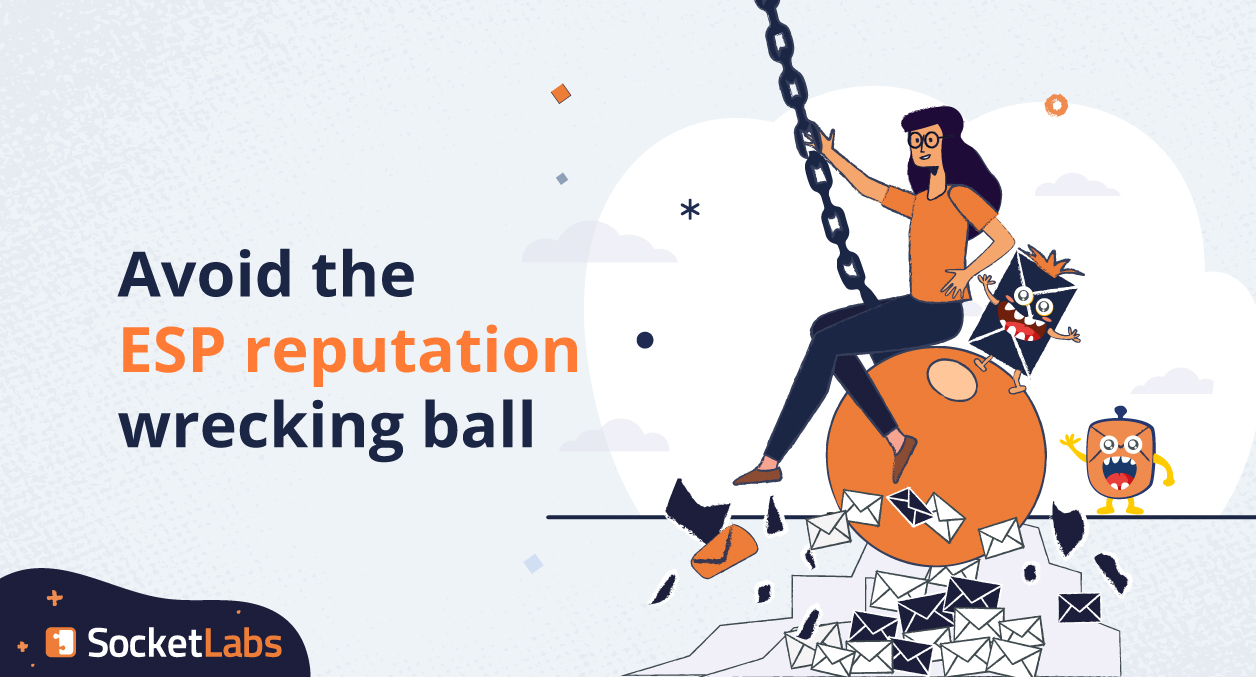
Right out of the gate, here is some advice: You should absolutely care about a bad reputation.
Complex senders like email service providers need to care about two different types of reputation to be able to feel secure in the market. First and most obviously, having adequate IP and IP pool reputation to better ensure reliable delivery is key. Without that, there’s very little reason for direct-sending customers to sign on your dotted line.
Secondly, ESPs need to be concerned about their reputation within the email ecosystem. If you’re unable to manage your reputation in the eyes of direct email senders, you’ll find the pool of potential customers start to dry up relatively quickly. At some point, your pool becomes deserted and your business becomes a swamp.
But the bad kind of swamp. A swamp-with-known-spammers-because-no-legit-senders-send-from-you swamp.
Or maybe even worse…a swamp that’s your only option.
Your reputation is serious business. We’ll walk you through the things to consider when evaluating which sending solution to push your senders’ mail through to let you sleep easier at night knowing it has your back.
Complex sender reputation wreckers
Regardless of which reputation you’re trying to protect, be it delivery or business, there are some key things to keep in mind to protect them both. The truth is, because they’re inextricably linked, keeping yourself out of trouble on the email-front (like staying on mailbox providers’ good side) will hopefully keep you out of trouble on the larger market-front (like finding and winning new business).
That being said, there are a few things you better stay on top of, so let’s get into it.
Email delivery
First, we’re talking email at large. Your ability to deliver mail quickly and reliably is at the very core of your reputation as a complex sender like an ESP. It’s not the only thing, but it’s probably the largest portion. Be on the lookout for these points of failure:
- Problems stemming from IPs and IP pools
If email coming from shared IPs and shared pools is not performing satisfactorily, you might find your ability to deliver email plunge. Even worse, if you’ve got good senders lumped in with less skilled senders, you could see great customers become super pissed when their email isn’t hitting inboxes…and rightly so. This kind of unreliability can be attributed to a few things, but most important to monitor is blocklistings (which could lead to a massive amount of failures) and poor IP reputations. - Service provider outages
Though infrastructure failure and total outages are rare, they’re possible. Without a backup, you can have complete sending stall, leaving businesses with critical email into a never-ending abyss…or at least that’s what it will feel like to them. Then you’ll have to run around trying to put out the fire by finding alternative ways to push out email while your provider gets it together. Additionally, the stress of an outage—even a partial outage on one or more IPs—will extend to support teams fielding angry customer calls and tickets. Hello, stress and overtime hours. How (not) nice to see you again.
If you’re using another ESP’s sending pipes, your ability to have control over both IPs and the reliability of your service is incredibly critical. You could be left waiting on other teams in your org to manually fix your IPs, and you could find your senders completely unable to send mail if your ESP experiences outages. You should consider adding another provider to your mix to reduce the risk.
Email-adjacent problems
OK, here we are. These are the issues usually associated with email but aren’t necessarily related to the sending and delivery of mail. Consider these more internal factors than external, but don’t get it twisted. They’re majorly important, too. If your ESP puts you at any of the risks below, they’re not helping you protect your reputation. They’re sabotaging it.
- Lack of email experience
Not one ESP is infallible. We can all admit that (right? RIGHT?). Where we have 99.999% reliability, it’s not 100%. That’s life, baby. But the really important thing here is whether a complex sender has email experts available to assist when needed. If you’re an ESP reliant on another ESP’s sending infrastructure, you need them to be knowledgeable about the issues you’re experiencing so you can pass that info onto your own senders. Otherwise, you might seem clueless when really, the folks without a clue are the people you’re paying to…you know, have a clue. - Inaccessible support
Beyond a lack of expertise is a lack of support, period. We’ve seen a number of places gatekeep meaningful and helpful support. Even if they have experts at the ready, unless you have the money to pay for it, you won’t get it. The only thing worse than bad support is no support at all. Without access to your ESP’s help team, you won’t get help and neither will your own senders. - Sudden and meaningful changes to the organization
We get it. We’re an ESP, too. BUT…changes come with a lot of risk. Let’s say your sending provider suddenly changes pricing for either sending service itself or the support they provide you. You need to choose between spending more money and passing the burden on to your customers or going without and passing that burden on to your customers as well. Either choice could totally tank your standing in the industry. Don’t forget about your own ESP’s business savvy. If they’ve made it difficult for you to keep your customers happy, they have an opportunity to bypass you as the middleman and poach them. Double whammy.
The ruins of a complex sender’s reputation
After whatever-it-is comes in like a wrecking ball (no gif needed), you’ll be standing in the ruins of your reputation. Though results may vary, you can usually expect a domino effect on your reputation, both on the delivery and community fronts.
The sequence of events might look like this:
- You fall short of your delivery expectations.
No matter the reason, the consequences remain the same. - Customers are mad.
Your services and support teams are thrown to the proverbial wolves, and a few things can happen here.- They either explain the issue is really rooted in the angry sender’s individual practices and advise accordingly…or another domino falls for your ESP and the customer realizes your support team lacks the email knowledge they expected it to have.
- They explain the issue is truly your fault as an ESP or complex sender and boom, immediate damage to your reputation as a reliable service provider is done.
- Your support team might be inundated with these situations, and you could find yourself paying exorbitant amounts of overtime pay. Plus, as time goes on, burnout becomes very real and you lose more headcount. Lots of collateral damage there, from diminished expertise to time and energy in onboarding new staff.
- Mistakes start to happen, and issues snowball from there. Beyond the obvious breach of customer trust, imagine if a mistake so large happened your IT and Support team lose hours of their time to fixing a mess affecting hundreds or thousands of senders. I’ve seen it myself. It was ugly.
- Frustrated customers switch ESPs.
Then, frustrated customers spread their negative experience to other senders in the community. What’s next?- The collapse of your reputation in the larger market. Poor word of mouth makes it incredibly challenging to win new business. Less new business, and revenue becomes a serious and stressful discussion.
- Not only does the community talk to one another, but you could find yourself with a poor reputation on respected review sites customers scour before making a choice about their ESP. Do you want to look good or not-so-good?
How to restore your reputation
The best offense is a good defense. These tips are multi-purpose. First, follow these tips if you want to avoid the kind of reputation ruin described earlier. But, if you need to build up a reputation a little down in the dumps, these recommendations will assist as well.
- Deliver reliably
Nail the basics before you try to get flashy with new tools or functionality. Make sure you’re authenticating properly, you’re managing suppressions, you’re monitoring IP reputations, and have plans in place for any X factors you might encounter. The priority here is getting mail to the inbox and without a good vehicle to do so, your customers’ mail will be stranded. - Optimize proactively
Don’t wait until problems arise or expect your customers to call you angrily after finding a problem themselves. Have a better sense of what’s going on at all times and have contingency plans in place to help mitigate issues. You need to enable near-real time reactions and prioritize proactive customer communication. - Provision intelligently
Have standards and a clear acceptable use policy, and get all teams on board with enforcing it to the letter. Avoiding bad senders and spammers can do wonders for both your industry reputation, because the community loves to do as much as they can to prevent abuse, and your operational reputation because your IPs and such should be more effective. - Minimize disruptions in service
This is two-fold. If you include an additional ESP to support your senders, you can better protect your senders from a complete shutdown in delivery. It’s simple business continuity for them, and a cushion to resolve issues for you. We recommend having two ESPs between which you can split traffic, and with that, you’ll be seen as a more reliable sending platform because you will be! You’ll also be able to compare those providers head-to-head on everything from performance and reliability to support and expertise…and of course, cost. - Provide superior customer service
Major, major one here. Look alive. If you can be proactive in both detecting and resolving issues before your senders even realize there is anything wrong, your ability to approach them with information about what happened and how you stopped it will raise customer confidence and support retention. Beyond that, the ability to confidently and knowledgeably find ways to guide, inform, and improve sender behavior (and thus, hopefully, performance), you’re providing a true service well worth the investment they’ve made in your ESP. This ability to be proactive lies squarely within your sending solution’s capabilities for you, a complex sender, to use.
Complex senders have complex reputations
There you have it. You have a big choice as an ESP: Protect your reputation or be tasked with rebuilding it from rubble. The good news is you don’t have to gamble with these really important risk factors. Instead, you can hedge your bets against them. As an ESP ourselves, we’re somewhat invested in this “reputation” thing. Our mission is to make it easier on all of us in this competitive market, so we’ve built an email sending platform equipped with every tool complex senders always wanted. From automated rules to help you shape email traffic intelligently, to a dashboard with urgency-scoring that quickly identifies problem senders and issues you need to tackle with priority…we’re living the ESP dream.
Are you?








